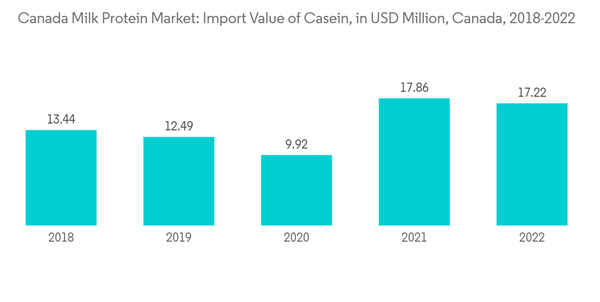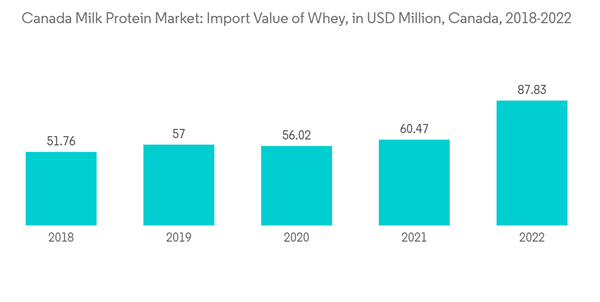Key Highlights
- In the milk protein market, milk protein isolates are gaining a lot of attention, as milk protein isolates are suitable for lactose-intolerant consumers and available at higher costs. The ease of use offered by powdered supplements contributes to the segment's growth. Consumers' reliance on suplements to satiate their protein needs also drives growth.
- Milk protein hydrolyzed is projected to be the fastest-growing milk protein type. Its increasing application in personal care and cosmetics is anticipated to drive the segment. The rising gym membership rates and a rising number of trainers recommending protein intake are projected to propel the growth of supplements during the forecast period.
- Additionally, demand for milk protein may rise as a result of population growth or an increase in the percentage of people who need more protein. Further, the demand for milk protein has increased as a result of its use in a variety of food products, such as functional foods, protein bars, and sports nutrition supplements. Moreover, companies are launching innovative products using milk protein as a key ingredient.
- For instance, Saputo announced the launch of the Joyya brand of ultra-filtered milk in Canada, claiming that milk in the range contains approximately 75% more protein and 25% less sugar than regular milk. Hence, trends in dietary preferences in favor of more protein- and health-conscious food choices, including milk protein products, drive the market.
Canada Milk Protein Market Trends
Increasing Demand for Supplement Nutrition, Processed Food and Beverages.
- There is an increase in demand for the supplement industry. This can be attributed to the high demand recorded by the supplement industry, especially in sports nutrition. The growing demand for milk protein in baby food and infant formula is also influencing the market growth. Due to their ability to deliver both whey proteins and casein, milk proteins remain a smart choice for bodybuilders. Additionally, their unaltered protein composition makes them the most natural protein type available in the market. This further boosts their popularity among consumers seeking the least processed ingredients in their purchase.
- Alternatively, the food and beverage industry was majorly driven by the beverage and bakery sectors. Milk proteins are gaining popularity in low-acid beverages due to their attributes offering greater solubility and heat stability. For example, the casein ingredients have wide applications in coffee/tea whiteners, whipping powders, and imitation milk. Milk contains casein protein that provides milk its white color.
- For instance, according to the UN Comtrade, the import value of casein in Canada accounted for USD 17.220 million in 2022. Thus, the increasing application of casein in food and beverages is further driving the market forward.
Whey Protein Holds the Significant Market Share in Milk Protein Market
- Whey proteins, due to their wide application in the food industry, hold a significant market share in the milk protein market. According to the International Journal of Health Sciences and Research articles, they stated that whey protein consists of various functional properties such as solubility, water binding, emulsification, gelation, flavor binding, foaming, etc. Thus, whey and whey components are considered value-added ingredients in many foods, including infant formulas, dairy, meats, sports nutrition foods, confections, bakery, beverages, snack foods, and other food products.
- For example, according to the UN Comtrade data, the import value of whey protein in Canada accounted for USD 87.828 million, which is a significant increase from when compared to the 2021 import value, which accounted for USD 60.473 million. The significant import value indicates the increasing demand for whey protein in the milk protein market.
- For instance, In 2021, Arla Foods Ingredients introduced a new whey protein ingredient to help meet the demand for high-protein yogurts. Nutrilac FO-7875 allows manufacturers to develop yogurts (both spoonable and drinkable) with higher protein content. Hence driving the milk protein market in the country.
Canada Milk Protein Industry Overview
The Canada milk protein market is highly fragmented. The major foreign players in the market are Farbest-Tallman Foods Corporation, Fonterra Co-operative Group Limited, Glanbia PLC, Kerry Group PLC, and Milk Specialties Global (sorted alphabetically). Further, the companies have been introducing new and innovative ingredients using milk proteins so as to make their product unique from the existing products. Owing to the rapidly developing nature of the market, new product innovation has become the most commonly used strategy among all, as it helps in understanding the changing needs of the various application industries in the market. Therefore, companies are focusing on offering milk proteins for various application industries.Additional Benefits:
- The market estimate (ME) sheet in Excel format
- 3 months of analyst support
This product will be delivered within 2 business days.










